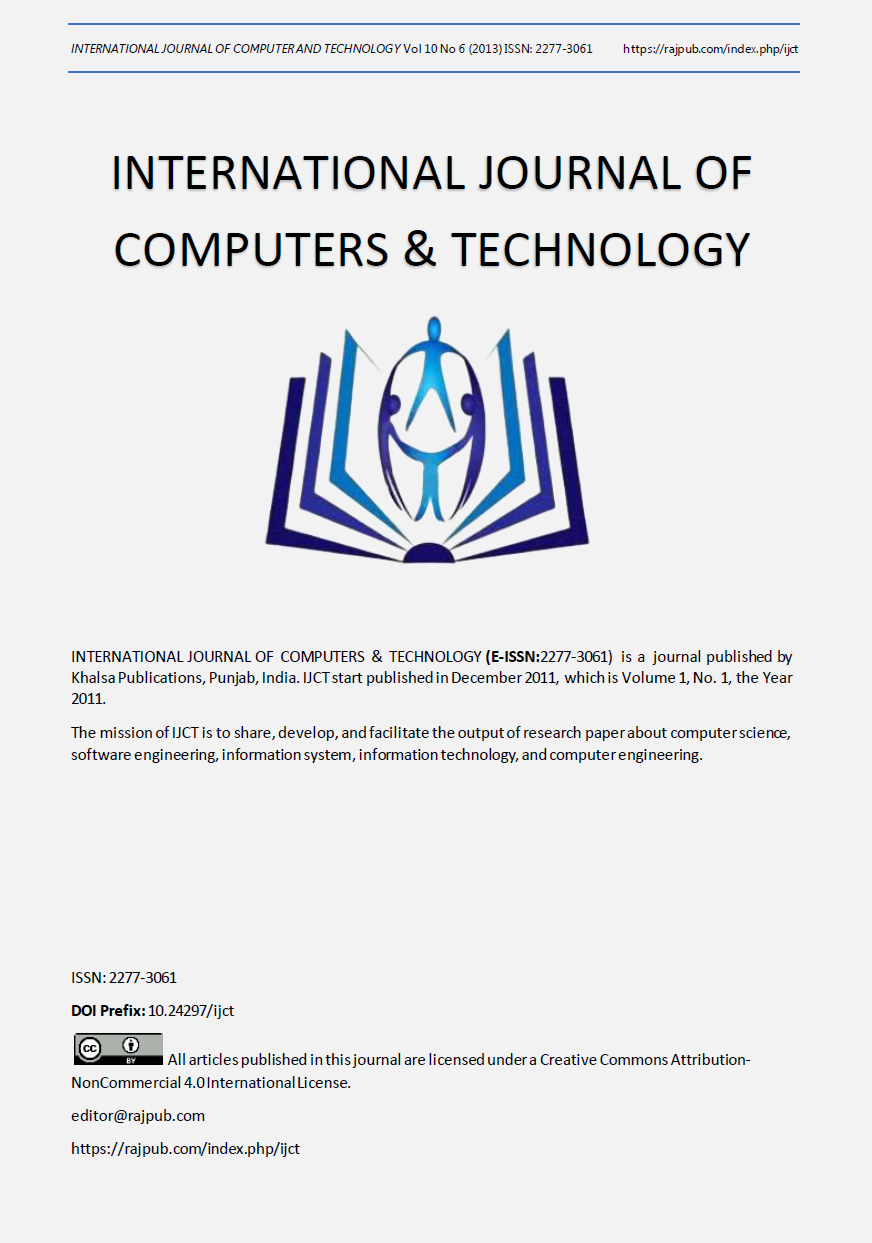A Prototype for the analysis of Conflict resolving Algorithms in Context aware Environment using simulation
DOI:
https://doi.org/10.24297/ijct.v10i6.7011Keywords:
CEAR Diagrams context, context aware systems conflict degree, decision table, fitness degree, precision, ubiquitous, rough set, UID (user identity)Abstract
In this paper we are proposing a GUI based Prototype for user centered environment like class room, library hall, laboratory, meeting hall, coffee shop, kitchen, living room and bedroom, which recommends useful services based on the user’s context. Service recommendation is mainly based on parameters such as user, location, time, day and mood. In
addition whenever the conflict arises among different users it will be resolved using some conflict resolving algorithms. The motivation behind the proposed work is to improve the user satisfaction level and to improve the social relationship between user and devices The prototype contains simulated sensors which are used to capture the raw context information, which is then described with meaningful English sentence and services are recommended based on user’s situation. The proposed conflict resolving algorithms are Rule based algorithm, Bayesian probability based algorithm and Rough set theory based algorithm. The amount of conflicts resolved by these algorithms is also analyzed at the end.
Downloads
References
[2] Design and Implementation of Prototyping Simulator of Context Aware Applications ByThyagaraju.G.S, U.P.Kulkarni. S.D.M.C.E.T. Research Centre, VTU, Dharwad, Karnataka, India
[3] Algorithms to Resolve Conflict in Multiuser Context Aware Ubiquitous Environment By Thyagaraju.G.S, U.P.Kulkarni. S.D.M.C.E.T. Research Centre, VTU, Dharwad, Karnataka, India
[4] Intro to Context-Aware Computing by Matthew Lee
[5] Context-aware computing applications by Bill schilit, Norman Adams and Roy Want.
[6] Context-awareness in wearable and ubiquitous computing by Gregory D Abowd, Anind dey, Robert orr and Jason Brotherton.
[7] survey on context aware system by Matthias Baldauf
[8] A Conceptual Framework and a Toolkit for Supporting the Rapid Prototyping of Context-Aware Applications Gregory D Abowd and Anind dey
[9] SenSay: A Context-Aware Mobile Phone by Daniel Siewiorek, Asim Smailagic, Junichi Furukawa, Neema Moraveji, Kathryn Reiger, and Jeremy Shaffer.
[10] CA4IOT: Context Awareness for Internet of Things by Charith Perera y, Arkady Zaslavskyy, Peter Christen and Dimitrios Georgakopoulosy
[11] Torben Weis eta al., Â\Rapid Prototyping for Pervasive Applications., IEEE Pervasive Computing, vol. 6,no. 2, pp. 76- 84, April-June 2007, doi:10.1109/MPRV.2007.41
[12] C. Becker et al., Â\PCOM.A Component System for Pervasive Computing,. Proc. 2nd IntÂfl Conf. Pervasive Computing and Comm. (PerCom 04),IEEE CS Press, 2004, pp. 67.77.
[13] J. Hill et al., Â\System Architecture Directions for Networked Sensors,. SIGPLAN Notes, vol. 35, no. 11, 2000, pp. 93. 104.
[14] Â\Playing with the Bits. User-configuration of Ubiquitous Domestic Environments Jan Humble*, Andy Crabtree, Terry Hemmings , Karl-Petter Akesson*, Boriana Koleva, Tom Rodden, Par Hansson*
[15] UBIWISE, A Simulator for Ubiquitous Computing Systems Design John J. Barton, Vikram Vijayaraghavan Mobile and Media Systems Laboratory HP Laboratories Palo Alto HPL-2003-93 April 29th , 2003*
[16] Content-based Recommender Systems: State of the Art and Trends by Pasquale Lops, Marco de Gemmis and Giovanni Semeraro.
[17] Content-Boosted Collaborative Filtering for Improved Recommendations by Prem Melville and Raymond J. Mooney and Ramadass Nagarajan.
[18] Rough set theory and its applications by Zdzis.aw Pawlak.
[19] An Introduction to Rough Set Theory and Its Applications A tutorial by Zbigniew Suraj
[20] Rapid Prototyping for Pervasive Applications by Torben Weis and Mirko Knoll Andreas Ulbrich and Gero Muhl Alexander Brandle
[21] A Framework for Programming Robust Context-Aware Applications by Devdatta Kulkarni and Anand Tripathi, Fellow, IEEE
[22] A tutorial-based guide to the ROSETTA system: A Rough Set Toolkit for Analysis of Data by Torgeir R. Hvidsten.
[23] Comparing the performances of Neural network and Rough set Theory to reflect the Improvement of prognostic in medical data By Nur Aniza Bt Alang Ismail
[24] Rough Set- A Tutorial by Jan Komorowski, Lech Polkowski , Andrzej Skowron
[25] ROSETTA Technical Reference Manual by Aleksander Ohrn.









